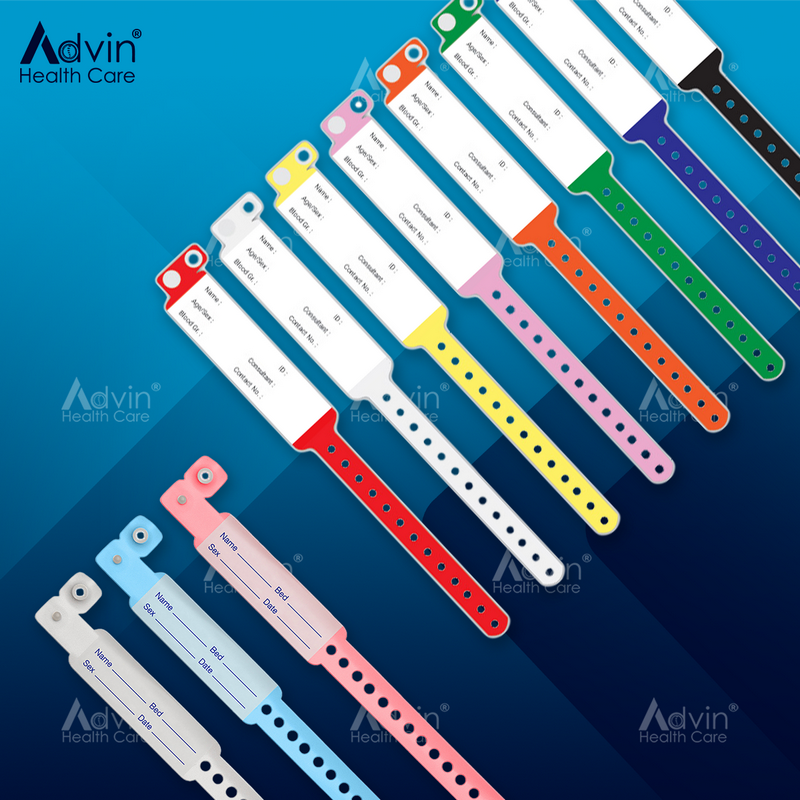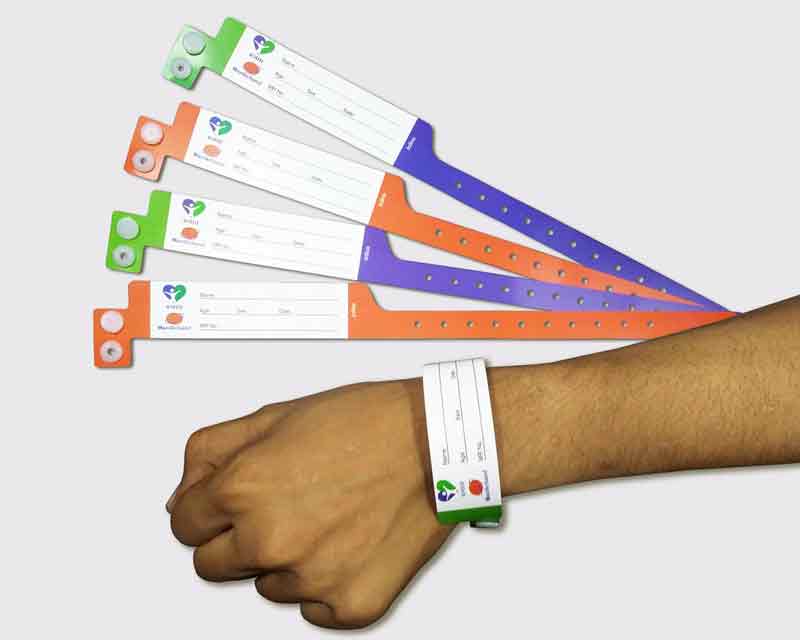Discovering the Different Kinds Of Patient Identification Band Used in Clinical Facilities
In the intricate world of medical care, the important duty of Patient Identification bands usually goes unnoticed. These bands, differing from simple paper wristbands to sophisticated RFID bands, create the backbone of Patient security methods, guaranteeing accuracy in Patient Identification.
Understanding the Value of Patient Identification Bands
While they may appear like plain accessories, Patient Identification bands play a crucial duty in medical facilities. These bands work as a critical tool for verifying Patient identification, protecting against medical errors associated with misidentification. The bands commonly display vital info such as the Patient's name, age, blood kind, and any kind of well-known allergies. They enable healthcare professionals to quickly access this important information, thus assisting in punctual and exact clinical therapy. Patient Identification bands additionally help in streamlining administrative jobs, ensuring precise record-keeping and invoicing. In spite of their simpleness, these bands symbolize the concept of Patient security, a foundation of quality healthcare. Without them, the risk of medical mistakes, and subsequently, Patient damage, may substantially boost.
Conventional Paper Wristbands: Their Usage and Limitations
Typical paper wristbands have actually been a staple in Patient Identification across numerous clinical facilities. While their use prevails, they harbor particular restrictions that might affect their effectiveness in Patient administration. This area will certainly focus on the extent of their application and the fundamental drawbacks connected with their use.
Paper Wristbands: Use Scope
In the world of Patient Identification, paper wristbands have long held a critical function. These bands are typically made use of in outpatient settings, where the Patient's stay is momentary. The wristbands contain crucial info such as the Patient's name, date of birth, and a special Identification number. This easy, yet effective system, enables doctor to promptly and precisely recognize clients, guaranteeing the proper treatment is carried out. Paper wristbands are also utilized in emergency situation situations, where fast Identification is critical. Their use encompasses occasions like blood donation drives and mass inoculation programs, even more stressing their versatility. In spite of innovations in technology, the simple paper wristband continues to be a dependable and economical service for Patient Identification in numerous healthcare scenarios.
Limitations of Paper Wristbands
Despite their prevalent usage, paper wristbands are not without their downsides. In addition, paper wristbands often do not have the technological abilities of more contemporary alternatives, such as barcoding or RFID chips, restricting their functionality to just displaying created information. Paper wristbands can trigger discomfort or skin irritability to some clients, specifically when used for extensive periods.
Barcoded Wristbands: Improvements in Patient Identification
While Patient Identification has actually long been a critical element of healthcare, the advent of barcoded wristbands signifies a significant jump onward. These bands take advantage of the simpleness of barcoding technology, permitting Patient info to be swiftly scanned and accessed. They enhance the speed and accuracy of Patient Identification, lowering the threat of clinical errors associated to misidentification. Barcoded wristbands are cost-effective, easy to generate, and eliminate handwriting errors typical with hand-operated systems. They are not without restrictions. While they use renovations over traditional bands, the barcode can end up being worn or smudged, providing it unreadable. Regardless of this, barcoded wristbands continue to be an important tool in contemporary health care setups, signifying the junction of modern technology and Patient treatment.
Radio Frequency Identification (RFID) Bands: an Action In The Direction Of Futuristic Health Care
The development of Patient Identification bands has actually caused the introduction of Radio Frequency Identification (RFID) Bands (patient identification band). These cutting-edge tools existing essential advantages for medical care centers, providing a more efficient and highly advanced means of Patient Identification. The application of RFID in healthcare is a substantial action towards a more advanced method to Patient monitoring and security
Comprehending RFID Bands

RFID Bands: Key Benefits
Accepting a future where innovation and healthcare merge, radio regularity Identification bands use a number of key benefits. Largely, these bands enhance Patient safety by giving precise, instant Identification, therefore lowering medical errors. RFID bands can save a huge amount of Patient data, including clinical history and allergies, making it possible for customized care. They additionally improve administrative jobs, as the automated data access replaces hand-operated procedures, improving performance and decreasing paperwork. RFID bands use real-time monitoring of individuals, critical in risky environments such as surgical treatment or intensive care. Last but not least, these bands are long lasting and immune to environmental aspects, ensuring constant functionality. On the whole, RFID bands represent a considerable innovation in Patient Identification innovation, profiting both patients and health care carriers.
Executing RFID in Health Care
As we tip right into a technically innovative period, the execution of RFID bands in medical care comes see to be significantly essential. These bands offer a seamless method to track and determine individuals, ensuring their security and improving efficiency in treatment procedures. RFID bands offer numerous benefits over typical Identification techniques. They can store a large amount of information, consisting of the Patient's medical history and therapy strategies, which can be quickly accessed by healthcare service providers. This data aids medical professionals make notified decisions regarding the Patient's treatment plan. click RFID bands reduce clinical errors by giving precise Patient Identification, which is important in preventing misdiagnosis or incorrect medication management. Therefore, the implementation of RFID bands is a substantial step in the direction of enhancing Patient security and healthcare shipment.

Color-Coded Wristbands: Aiding in Quick and Accurate Diagnosis
In the bustling setting of a clinical facility, color-coded wristbands have become crucial tools for swift and precise Identification of an individual's medical condition. These wristbands, put on by individuals, carry specific shades that represent different clinical conditions or statuses. Red can suggest allergy dangers, while yellow might indicate an autumn risk. This system is made to use immediate aesthetic cues to medical care suppliers, improving Patient security and care high quality. In emergency situation situations, the usage of these wristbands permits quick decision-making. Nevertheless, the effectiveness of color-coded wristbands depends upon the uniformity of color analysis across medical care organizations, calling for common criteria for consistent application.
Techniques for Efficient Execution and Monitoring of Patient ID Bands
Achieving optimum use of Patient Identification bands necessitates a well-structured method for their application and monitoring. Patient education and learning is likewise essential; people should understand the function of the bands and the need for their continuous Click This Link wear. It's important to have a back-up plan in area, such as barcode scanning or biometrics, to ensure that Patient Identification is never endangered.
Final thought
Patient Identification bands are important in medical facilities to make certain security and precision. Traditional paper, barcoded, RFID, and color-coded wristbands each hold special advantages, ranging from cost-effectiveness to innovative data storage and instantaneous medical notifies. Reliable implementation and administration of these bands can significantly decrease clinical mistakes, increase effectiveness, and boost overall Patient care. Hence, understanding and utilizing these Identification tools is vital for maintaining high standards in health care.
These bands, differing from straightforward paper wristbands to innovative RFID bands, develop the foundation of Patient safety and security protocols, making sure accuracy in Patient Identification.The evolution of Patient Identification bands has brought about the emergence of Radio Frequency Identification (RFID) Bands. Generally, RFID bands stand for a significant improvement in Patient Identification modern technology, benefiting both individuals and medical care service providers.
RFID bands minimize clinical mistakes by offering accurate Patient Identification, which is vital in protecting against misdiagnosis or wrong medicine management. Patient education is likewise vital; individuals have to recognize the objective of the bands and the requirement for their continuous wear.
Comments on “The Importance of Using a Patient Identification Band in Current Medical Practices”